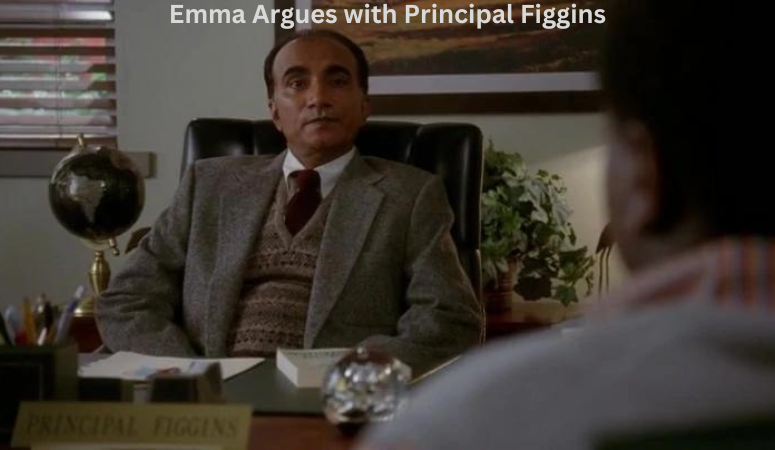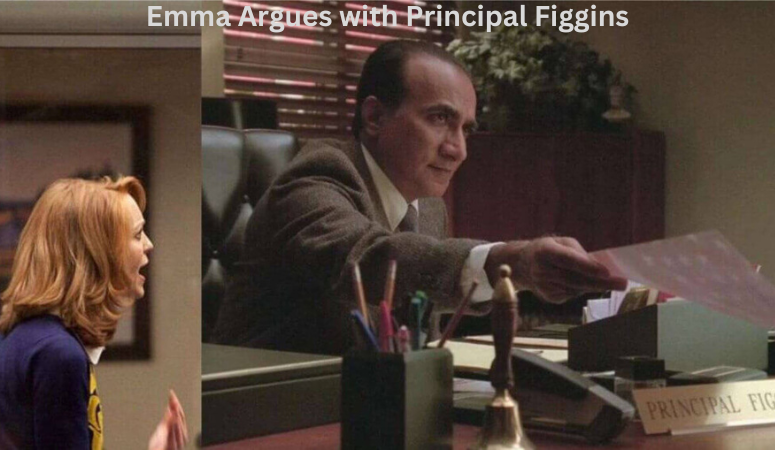Table of Contents
Experience the dramatic confrontation as Emma argues with Principal Figgins. Uncover the intense dialogue and pivotal moments in this compelling interaction that shape the narrative. Dive into the tension and intrigue of this pivotal scene, only a click away!
In the corridors of academic discourse, clashes between students and authority figures are not uncommon. One such riveting incident transpired when Emma, a spirited student, found herself in a heated debate with Principal Figgins. This encounter, laden with tension and passion, unfolded as a microcosm of the larger dynamics within educational institutions.
Emma Argues with Principal Figgins
Emma stomped into Principal Figgins’s office, her face flushed with anger. “This is ridiculous!” she shouted, slamming her hands down on his desk. “How can you possibly punish me for something I didn’t do?”
Principal Figgins looked up from his paperwork, his expression calm and collected. “Emma,” he said, “I understand that you’re upset, but I assure you that we have conducted a thorough investigation and have found no evidence to support your claims.”
The Prelude: Setting the Stage
Before delving into the war of words, it is vital to understand the context that caused this showdown. Emma, acknowledged for her advocacy and outspoken nature, had become the voice of a student frame longing for trade. Principal Figgins, on the other hand, embodied the established order, resistant to the winds of transformation.

Clash of Ideologies
Emma’s Perspective: A Quest for Change
Emma’s argument stemmed from a deep-rooted belief in the power of progressive educational reforms. She championed causes like updated curricula, enhanced student engagement, and a more inclusive learning environment. Her impassioned plea was not just for herself but for every student seeking a holistic and relevant education.
Principal Figgins’ Stance: Upholding Tradition
Principal Figgins, a custodian of tradition, defended the status quo. He argued that the institution’s time-tested methods had shaped countless successful individuals. Change, according to him, risked undermining the very foundations that had made the school reputable.
The Verbal Sparring: Words as Weapons
As the clash unfolded, the air resonated with articulate arguments and fervent rebuttals. Emma, armed with data on modern pedagogical approaches, eloquently articulated the need for adaptation. Principal Figgins, drawing on decades of experience, countered each point with a stern defense of the institution’s legacy.
The Ripple Effect: Impact on Students
Immediate Reactions
The clash between Emma Argues with Principal Figgins didn’t merely echo within the confines of the school. It reverberated among students, sparking discussions on the need for change versus the value of tradition. Lines were drawn, alliances formed, and the student body became a microcosm of societal debates on progress.
Long-Term Implications
Beyond the immediate aftermath, the incident prompted a reevaluation of the institution’s policies. Parents, students, and even faculty members engaged in a discourse that transcended the specific argument between Emma Argues with Principal Figgins. It catalyzed a collective contemplation on the role of education in a rapidly evolving world.
Lessons Learned: A Catalyst for Change
Institutional Adaptation
The institution observed itself at a crossroads in the wake of the conflict. Recognizing the need for evolution, a committee comprising college students, teachers, and administrators turned into fashioned. This marked the start of a collaborative effort to combine the exceptional lifestyle with the demands of cutting-edge technology.
Student Empowerment
Emma’s impassioned stand not only influenced institutional changes but also inspired students to actively engage in the decision-making processes. The clash became a symbol of the transformative power that a single voice, when amplified, could exert.

Final Words
In the grand tapestry of educational institutions, clashes like the one between Emma Argues with Principal Figgins are not anomalies but rather pivotal moments of metamorphosis. The collision of ideologies, though intense, often serves as a catalyst for positive change. Emma’s argument, echoing the sentiments of many, became a rallying cry for a more dynamic and responsive educational system.
People also ask
1. What was the argument between Emma and Principal Figgins about?
The clash between Emma and Principal Figgins centered around differing perspectives on the direction of the educational institution. Emma advocated for progressive reforms, including updated curricula and a more inclusive learning environment. Principal Figgins, in contrast, staunchly defended the traditional methods and values that had shaped the institution for years.
2. How did the clash impact the student body?
The clash had both immediate and long-term effects on the student body. In the short term, it sparked discussions among students, dividing opinions on the need for change versus the preservation of tradition. In the long term, it prompted a reevaluation of the institution’s policies, leading to collaborative efforts for positive changes.
3. What were the lessons learned from this incident?
The clash between Emma and Principal Figgins served as a catalyst for institutional adaptation. Recognizing the need for evolution, a committee was formed to integrate the best of tradition with modern demands. Additionally, the incident empowered students to actively engage in decision-making processes, emphasizing the transformative power of a single voice.
4. Did the clash result in any positive changes within the institution?
Yes, the clash led to positive changes within the institution. It prompted a reevaluation of policies and the formation of a committee for collaborative decision-making. These changes aimed to blend tradition with modern needs, fostering a more dynamic and responsive educational system.




